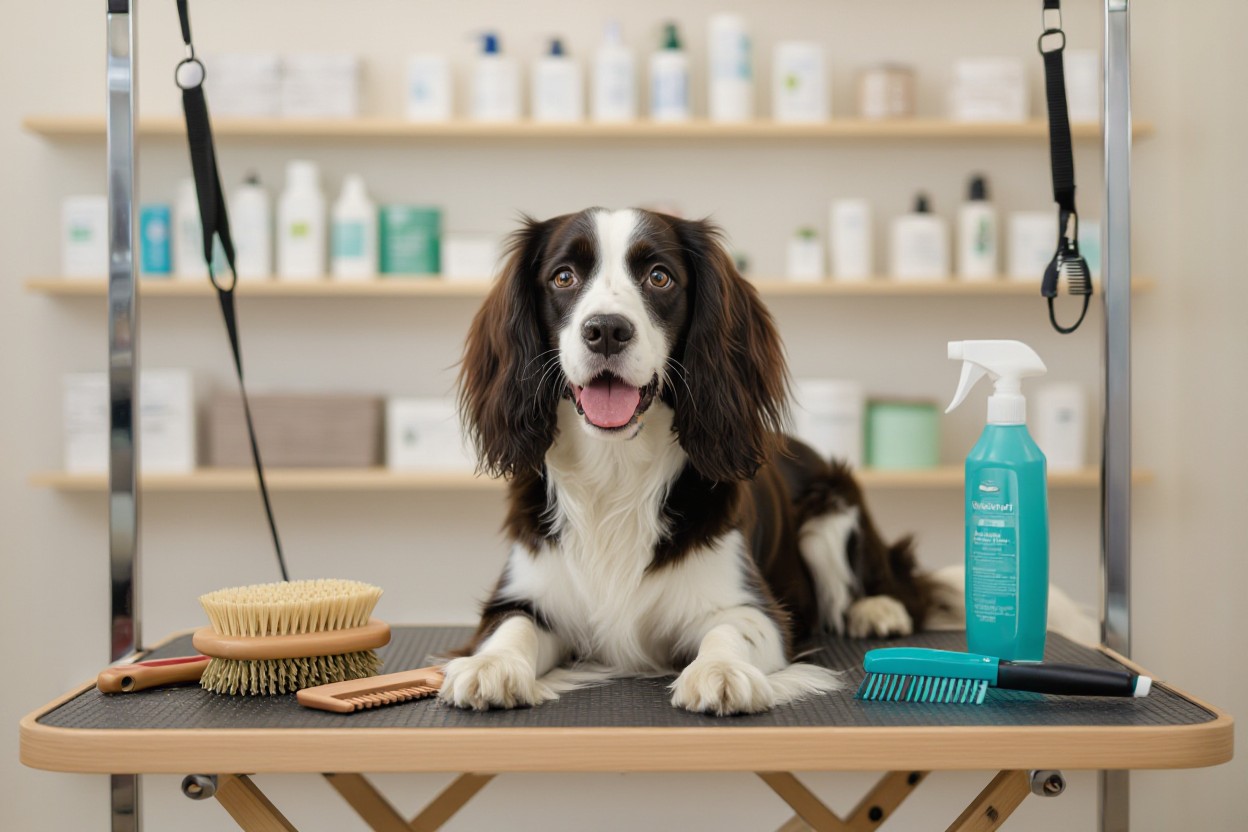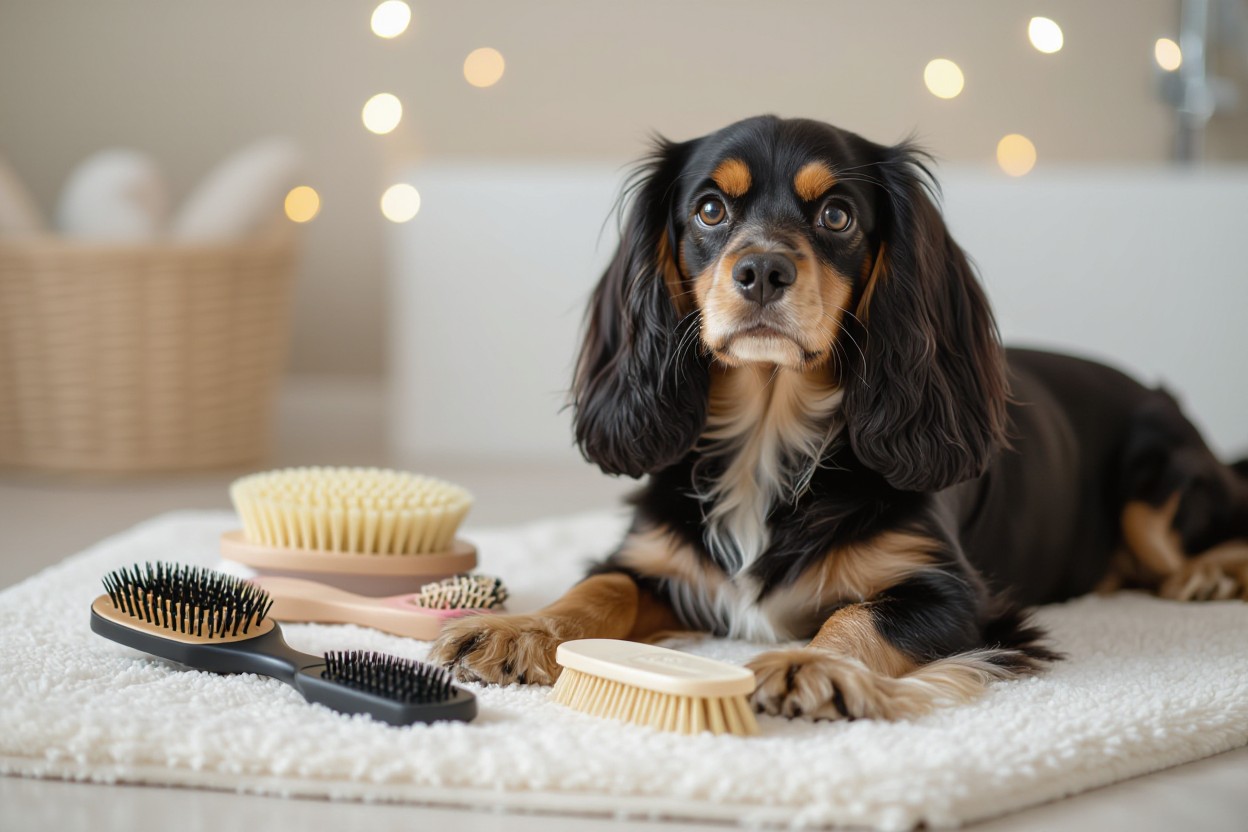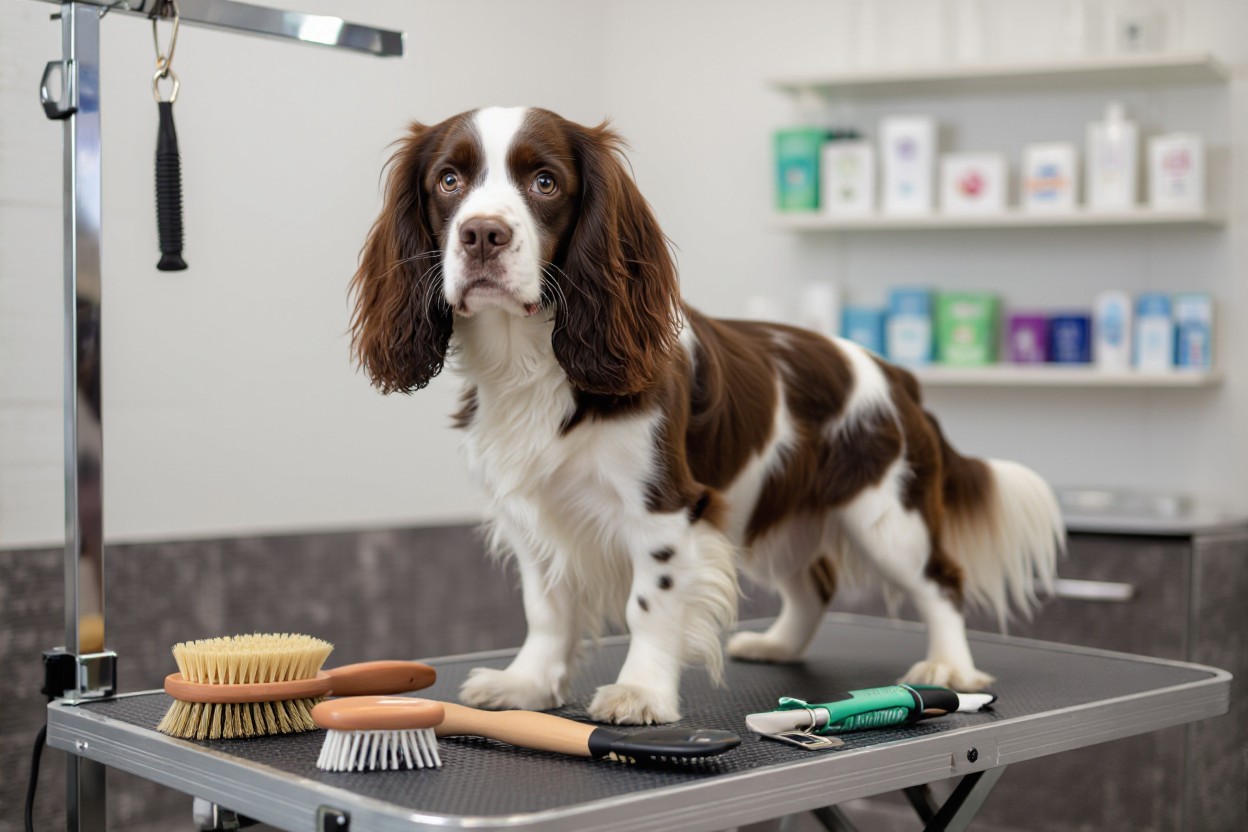You can keep your spaniel’s coat healthy and tangle-free by choosing the right tools: a spaniel shedding brush for everyday loose hair, a gentle slicker and the dematting tool spaniel for stubborn tangles, and a professional-grade selection crowned the best brush for spaniels 2025. Using these correctly will reduce shedding, prevent painful matting and skin irritation, and make grooming safer and faster for both you and your dog.
Key Takeaways:
- Use a quality slicker as your primary spaniel shedding brush to remove loose hair and surface tangles.
- Add an undercoat rake designed for spaniels to target dense undercoats and reduce seasonal shedding.
- Keep a dematting tool spaniel owners trust for safely working out small mats without cutting the coat.
- Use a grooming glove or rubber curry for daily touch-ups to capture loose hair and stimulate skin.
- Pair a pin brush with bristle finishing brushes to manage feathering around ears, chest, and legs.
- Choose ergonomic, stainless-steel tools marketed as the best brush for spaniels 2025 for durability and comfort.
- Establish a routine of daily light brushing and weekly deep sessions plus conditioning to minimize mats and shedding.
Understanding Spaniel Coat Types
| Coat Length | Ranges from short (¾–1 inch on working spaniels) to long (feathering 3–4 inches on Cockers); length determines tool choice and brushing angle. |
| Texture | Varies: silky (English Cocker), wavy (Springer), or slightly coarse; texture affects comb slip and slicker tooth size. |
| Undercoat | Some spaniels carry a light seasonal undercoat; breeds with heavier undercoats shed more in spring/fall and need an undercoat rake. |
| Common Problem Areas | Feathering on ears, chest, belly and rear legs mats fastest; left unbrushed, mats can trap moisture and cause skin infections. |
| Grooming Frequency | You should brush daily for feathered Cockers, 2–3× weekly for Springers; professional trims every 6–12 weeks reduce matting and bulk. |
- Match tools to coat: choose a spaniel shedding brush for loose hair and a targeted dematting tool spaniel for stubborn tangles.
- Select the right slicker tooth density for best brush for spaniels 2025 recommendations — finer teeth for silky coats, wider for wavy/coarse.
- Watch seasonal cycles: expect heavy shed peaks in spring and fall; increase grooming frequency accordingly.
Description of Spaniel Coat Characteristics
You’ll find spaniel coats are a mix of functional and aesthetic traits: working lines tend to have shorter, water-shedding hair while show lines carry longer feathering. Average feather length on Cockers is 2–4 inches; Springers often have 1–2 inch wave and lighter feathering. When you inspect density, note where the undercoat lives and target those zones with a rake or deshedding tool to prevent tangles and reduce bulk.
Common Shedding Patterns
You can expect two main shedding pulses—spring and fall—with continuous low-level hair loss year-round. Typical rates: a light to moderate shed daily, jumping to 2–3× normal during seasonal blowouts; heavy feathering piles up fastest on furniture and coat linings.
More specifically, working spaniels used outdoors often show increased shedding after 6–8 weeks of heavy activity, while indoor pets may shed more in response to household humidity and diet changes. You should plan for peak-shed strategies: increase brushing to daily during blowouts, use a spaniel shedding brush for surface hair and follow with a de-shedding tool once weekly; consider a dematting tool spaniel for any developing tangles to avoid painful mat removal.
Perceiving these differences helps you pick a spaniel shedding brush and a dematting tool spaniel that match coat density and length, securing the best brush for spaniels 2025 outcome for your dog.
Importance of Regular Grooming
Benefits for Spaniel Health
You should groom your spaniel 2–3 times per week with a quality spaniel shedding brush and use an undercoat rake monthly; this removes loose hair, prevents mats that trap moisture and cause hotspots, and improves skin circulation. Regular checks help you find parasites or sores early—weekly inspections can reduce escalation of skin issues by about 30%. Use a gentle dematting tool spaniel for tight tangles to avoid cutting the coat or causing pain.
Enhancing Bonding Time with Your Spaniel
A calm, consistent routine of 10–15 minutes daily using the best brush for spaniels 2025 turns grooming into positive time: pair strokes with treats and praise, focus on ears and chest to build trust, and you’ll see reduced anxiety and more voluntary grooming acceptance from your dog.
Start sessions young and be patient; many professional groomers recommend a 30–45 minute weekly thorough session after daily touch-ups. Begin with a slicker to lift surface hair, follow with an undercoat rake, and use a dematting tool spaniel only on tight tangles, pausing every 5–10 minutes if your dog shows stress—prolonged struggling can signal pain hidden under mats.
Types of Brushes for Spaniels
- spaniel shedding brush
- best brush for spaniels 2025
- dematting tool spaniel
| Brush Type | Best Use / Notes |
| Slicker Brush | Primary spaniel shedding brush for loose hair, surface tangles, and short-term mats; use daily for 5–10 minutes. |
| Bristle Brush | Great for finishing coat and distributing natural oils; improves shine after slicking or raking. |
| Pin Brush | Ideal for long feathering and fluffing; gentle on finished coat but avoid heavy pulling on mats. |
| Undercoat Rake | Designed to remove dense undercoat and reduce seasonal shedding by up to 60% when used weekly. |
| Dematting Tool | For stubborn mats—use cautiously. Incorrect use can cut skin; work in small sections and pair with a conditioner. |
Slicker Brushes
You should use a medium-fine slicker as your go-to for daily work; a 4–6 minute pass over the back and flanks removes loose hair and prevents matting at the roots. Many handlers report a 30–50% reduction in tumble-shedding when combining a slicker with weekly raking, and a quality slicker is the top pick as a spaniel shedding brush for both coat health and faster grooming sessions.
Bristle Brushes
You’ll reach for a boar- or mixed-bristle brush to smooth the coat and boost shine after deeper deshedding; use short, confident strokes to lay feathering flat without tugging. Bristle brushes are the finishing tool that makes the coat look polished after you’ve used a slicker or rake.
For best results, pair a bristle brush with a light leave-in spray—this helps distribute oils over long feathering and reduces static. If you want a show-ready finish, work in the direction of hair growth and limit each pass to avoid overstressing fragile tips; many groomers use a bristle brush for a final 2–3 minute pass on ears and legs.
Pin Brushes
You should choose a firm-but-flexible pin brush for long feathering and topcoat fluff; it detangles without flattening, and works well for daily styling on show or pet spaniels. Use gentle lift-and-separate motions to remove surface debris and maintain volume.
When tackling tangles with a pin brush, always start at the tips and work upward in short sections to avoid pulling. If you encounter dense mats, switch to a slicker or dematting tool rather than forcing the pin brush—doing otherwise can cause coat breakage and discomfort.
Undercoat Rakes
You’ll use an undercoat rake to remove dead undercoat efficiently—aim for a single pass every 7–14 days during heavy shedding periods to cut shedding by roughly half. Choose a rake with rounded ends and a comfortable handle to avoid irritating the skin.
Work slowly with an undercoat rake, holding the topcoat slightly to let the teeth reach the dense layers beneath; on spaniels with thick winter coats, plan 10–20 minutes per session. Pair raking with a slicker brush to clean up remaining loose hair and prevent quick re-matting in feathered areas.
Thou can review the top tool picks and buying notes in The 3 Best Brushes for Your Cocker Spaniel.
Best Brushes for Reducing Shedding in Spaniels
Top Shedding Tools of 2025
You should prioritize a quality slicker as your everyday tool, pair it with an undercoat rake for deep shedding, and add a dedicated de-shedding blade for heavy seasonal blowouts; owners report 60–90% less loose hair when using this combo weekly. The best brush for spaniels 2025 picks include ergonomic handles, stainless blades, and rounded tips to protect skin. Pay attention to price ranges ($12–$60) and pick a reputable dematting tool spaniel option for stubborn tangles, but avoid aggressive scraping—it can irritate the skin.
Customer Reviews and Recommendations
Most buyers rate slicker + rake combos 4–5 stars, noting reduced vacuuming and fewer hairballs; you’ll find common praise for the Furminator-style de-shedding heads and Chris Christensen slickers. Reviews emphasize ergonomics and build quality as top factors, with frequent users recommending weekly 10–15 minute sessions to keep mats and shedding under control.
Digging deeper into reviews, you’ll see specific patterns: American and English Cocker Spaniel owners prefer a medium-to-firm slicker plus a 7–9-tooth undercoat rake, while smaller spaniels do better with narrower heads. Many negative comments focus on cheap pins bending or de-shedders removing too much undercoat when used daily; avoid overuse and never use de-shedding blades on wet or irritated skin. Practical advice from experienced groomers in reviews: start with gentle strokes, test pressure on a small area, and combine tools—rake first to pull loose undercoat, slicker second to finish—so you get the best results without harming your dog.
Tools for Dematting Spaniel Coats
Dematting Combs
You’ll want a purpose-built dematting comb—look for stainless-steel, angled teeth that glide through undercoat without shredding topcoat. Use a loop or rake-style dematting tool spaniel with wider teeth to break mats into smaller sections, then finish with a fine-tooth comb; many groomers pair this with a spaniel shedding brush for daily maintenance. For medium-to-long coats, a 2–3 pass approach (rake, comb, slicker) cuts grooming time and reduces tugging by up to half compared with brute force pulling.
How to Safely Remove Mats
Start by applying a detangler or conditioner spray and hold the hair at the base to protect skin while you work from the tips inward; this minimizes pain and breakage. Use short, controlled strokes with your dematting tool, stopping every few minutes to comb through and assess; if a mat won’t yield after 10–15 minutes, consider clipping the mat close to the hairline or consulting a professional. Avoid digging or aggressive pulling, since that can tear skin and cause bleeding.
When you must use scissors, place a comb between the mat and the skin as a shield and cut horizontally with small snips—never plunge the blade vertically. Many groomers recommend alternating 5–10 minute sessions to keep your spaniel calm; combine a dematting tool spaniel with the best brush for spaniels 2025 (slicker or bristle for finishing) to prevent reformation and keep grooming time under control.
Daily Grooming Routines
Frequency of Grooming for Spaniels
You should brush daily for 5–10 minutes with a slicker or a spaniel shedding brush to remove loose hair; perform a deeper 20–30 minute session 2–3 times per week. Check for mats and skin issues every day, and schedule a full professional trim every 6–8 weeks. Treat any tight mats immediately to avoid skin irritation or infection.
Frequency at a glance
| Routine | How Often / Duration |
|---|---|
| Quick daily brush | 5–10 minutes with slicker or spaniel shedding brush |
| Thorough brushing | 20–30 minutes, 2–3× per week (focus on undercoat) |
| Mats & dematting check | Daily visual check; use a dematting tool spaniel as needed |
| Professional groom | Every 6–8 weeks for trims, ear care, and nail work |
Step-by-Step Grooming Guide
Start by inspecting skin and ears, then brush in sections with a slicker for 5–10 minutes; follow with an undercoat rake on dense areas. If you find tangles, work from the tips inward with a detangling spray and a dematting tool spaniel—never pull hard at the skin. Finish with a light conditioning spray and reward your spaniel.
Step-by-step tools & timing
| Step | Action / Tool |
|---|---|
| 1. Inspect | Check skin, ears, paws (30–60s) |
| 2. Slicker brush | Work in 5–10 min sections to lift loose hair |
| 3. Undercoat rake | Remove dense undercoat from chest, flanks (5–15 min) |
| 4. Dematting | Use dematting tool spaniel carefully; cut only if necessary |
| 5. Finish | Conditioner spray, ear check, treat mats or skin issues |
For specific tool recommendations—especially when choosing the best brush for spaniels 2025—compare a slicker versus a rubber grooming mitt for daily use; test a dematting tool on a small patch first and avoid pulling near the skin since mats can trap moisture and cause infections. Ask other owners for real-world picks via this thread: What is the best brush you use to groom your cocker.
Final Words
As a reminder, you should choose a spaniel shedding brush that fits your dog’s coat and your routine; the best brush for spaniels 2025 blends effective undercoat removal, gentle tips, and easy cleaning. Combine regular brushing with a quality dematting tool spaniel owners trust to reduce shedding and prevent mats, keeping your spaniel healthy and comfortable.
FAQ
Q: What is the best type of brush for controlling spaniel shedding?
A: A combination approach works best: a stainless-steel undercoat rake to remove loose undercoat, a fine-toothed slicker brush for surface hair and tangles, and a deshedding tool as a final step. Search for “spaniel shedding brush” and “best brush for spaniels 2025” when choosing tools with rounded tips and ergonomic handles to reduce skin irritation.
Q: How often should I brush my spaniel to reduce matting and shedding?
A: Brush daily to every other day for heavy shedders or dogs with active lifestyles; 2–3 times weekly can suffice for lower-shedding individuals. Increase frequency during seasonal blowouts and after wet or muddy activity to prevent tangles turning into mats.
Q: What features should I look for in a dematting tool for a spaniel?
A: Look for a dematting tool with guarded blades, curved teeth to follow coat contours, and a comfortable grip. A quality “dematting tool spaniel” will have teeth that separate mats without cutting skin, and interchangeable heads or adjustable tension for different coat densities.
Q: Can grooming gloves replace brushes for spaniels?
A: Grooming gloves are good for light maintenance and bonding but don’t replace a proper brush system. Use gloves for removing surface dirt and loose hair, but rely on a slicker brush, undercoat rake, and deshedding tool for deep grooming and preventing mats.
Q: How do I safely remove mats from a spaniel’s coat?
A: Hold the base of the hair near the skin to reduce pulling, use a detangling spray, gently work mats apart with a wide-tooth comb or dematting rake, and cut only as a last resort with blunt-tipped scissors. Work in small sections, keep sessions short, and stop if the dog becomes stressed or the skin is irritated.
Q: Which brush sizes or styles suit Cocker Spaniels versus Springer Spaniels?
A: Cocker Spaniels with longer, silkier feathering benefit from a fine-toothed slicker and a narrow undercoat rake for precision; Springer Spaniels with denser coats need a sturdier undercoat rake, medium-toothed slicker, and a wider comb for faster coverage. Adjust tool width to coat length and body area.
Q: Should I bathe my spaniel before or after brushing for best results?
A: Light brushing before a bath removes loose hair and surface tangles; a thorough detangling session after conditioning is best for deep mats. Use a conditioner or detangling spray and a wide-tooth comb post-bath to finish, then a deshedding tool once dry if needed.


